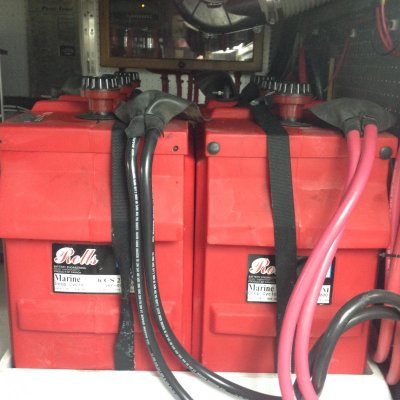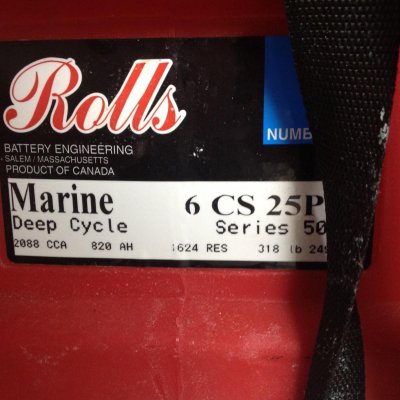The guy that answered this is not correct! 6 volt deep cycles are better because they weigh as much or more than a 12v. The weight comes from the amount of lead in the plates, the more lead the longer the battery will last.
And those saying the Ah rating stays the same are correct!
Yes more lead or thicker plates
often means longer life but this not always the case and the construction is also different between 12V marine batteries and golf or industrial batteries. Plate separators are better, grids are thicker the paste is different etc. etc..
Compare a pair of 6V Trojan T105's (GC-2) and a pair of 12V SCS-225's (G-31) for a 225Ah bank and a 260Ah.
Two 12V SCS-225's weigh 132 pounds and will deliver 260Ah's and 600 lab cycles to 50% DOD
Two 6V T105's weigh 132 pounds and will deliver 225Ah's and 1200 lab cycles to 50% DOD
Both banks weigh the same but the G-31 12V bank will deliver more ampere hours of capacity yet only half the lab cycles 600 lab cycles to 1200 lab cycles.
The problem is that consumers most often buy batteries based on Ah capacity or cost per Ah while totally ignoring cycling ability. The G-31's weigh the same as the T105's and deliver 35 more ampere hours so they must be better right? No, wrong..
If we look at the East Penn line and compare batteries of identical case sizes and only vary them the
type of battery.
East Penn 12V G-31
AGM -
300 Lab Cycles to 50% DOD - 69 Pounds
East Penn
Flooded 12V G-31 -
350 Lab Cycles to 50% DOD - 60 Pounds
East Penn
GEL 12V G-31 -
1000 Lab Cycles to 50% DOD - 70 Pounds
East Penn Flooded 6V GC-2 -
1000 Lab Cycles to 50% DOD - 64 Pounds
As can be seen a 1 pound difference in weight yields 700 more cycles between AGM & GEL. Nine pounds less weight yields 50 more cycles for the flooded battery over the AGM?

It is the construction and battery type that really define cycle life. Within the flooded category construction varies too.
Weight can not be the only determination of expected durability or cycle life. Heck two G-31 Trojans weigh the same as two T105's and can deliver 35 more ampere hours of capacity but they will only do so for half as long
in the lab. Equal weight boxes, more ampere hour capacity out of two of the 12V batteries, but
half the lab cycles. The Trojan golf car 12V T1275 at 150Ah's can also do 1200 lab cycles but the 12V G-31 (automotive case) can only do 600. If you were buying a 12V battery with 130Ah to 150Ah's which one makes the better choice, the one designed for golf car duty or the one that is an adapted automotive battery with a "marine deep-cycle" sticker? Considering that boats usually need more than 1 battery why spend money on cheap short lived 12V automotive type batteries when you can install batteries that can yield considerably better service life?
The design, intended purpose and construction of the battery play a large role in how it cycles and while weight & plate thickness plays a roll it does not have the impact people often think it does..
Again these are not my words but the words of a battery manufacturer who actually produces all the types of batteries being discussed.
Senior Battery Engineer - Major US Battery Manufacturer:
"Yes, for packs of equivalent energy content (voltage * capacity) the Golf Car types and L16's are 2-3 times better than the DC automotive sizes (24, 27 and 31)."
Note how he used the word "
automotive sizes" when stating they were 2-3 times lesser a battery than golf car or L-16 type battery....
This same manufacturer slaps the same "deep-cycle" label on G-24, 27 & 31's as they do L-16's, GC-2's, GC12V's etc.. Fair? Given what they stated above I'd say it's far from fair to the consumer..
Unfortunately we can't simply buy batteries based on Ah's to $$, as many, many consumers do, we also need to look at the manufacturers projected lab data to determine how they rate it for cycling compared to other batteries within their own brand. Trojan rates the 12V G24, 27 & 31 at just 600 lab cycles and the GC-2, GC12's, J185's, L16's etc at 1200 lab cycles, East Penn is similar...






